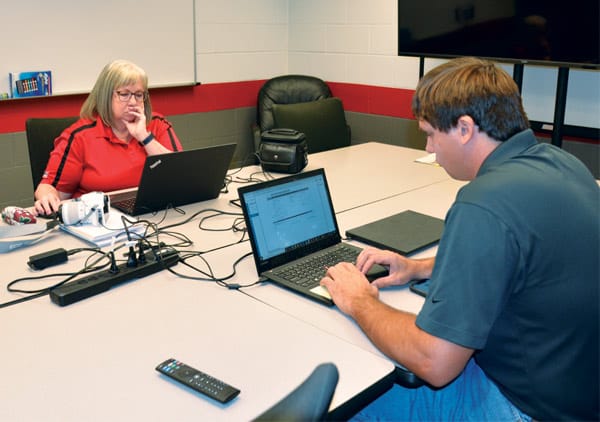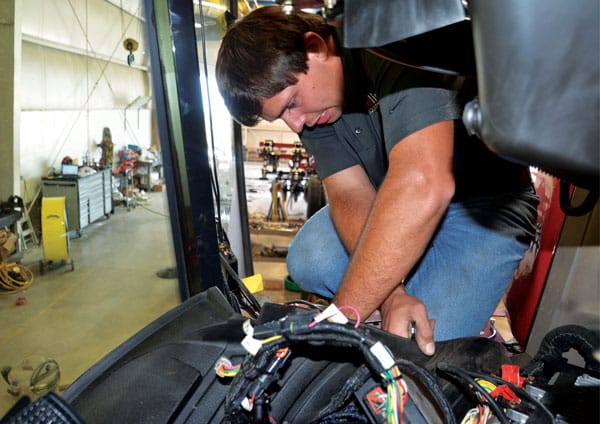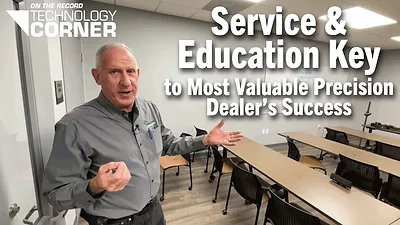A day in the life of a precision farming specialist is never the same, and that’s the way Calvin Knotts likes it.
“That’s exactly what my idea of a dream job was,” Calvin says. “I grew up on a farm, and I do some farming on my own, too, but my goal was to have a job where you could have a desk, but at the same time, get out, get dirty and work.”
Calvin is one of 4 precision farming specialists at Redline Equipment, a Case IH dealership with 12 locations across Indiana, Ohio and southern Michigan. Calvin serves approximately 150 of the dealership’s customers within a 3-store territory.
Most of the calls Calvin receives from customers involve Case IH’s Advanced Farming Systems (AFS) technology on equipment that they bought from the dealership, but he also does some occasional service work on other brands if it’s equipment brought in on trade. He talks to some customers on a weekly or monthly basis, while he only hears from others every couple of years.
I met Calvin at Redline Equipment’s Gas City, Ind., location in late August for my first Day in the Cab assignment. It was my 11th day on the job as an associate editor with Precision Farming Dealer and the first time in about 12 years that I’d been around that much farm equipment. Even then, my experience was limited to walking through the equipment showcase at Wisconsin’s Sheboygan County Fair to get to the horse barn and the buildings that housed the various arts and crafts projects I’d made as a 4-Her.
My visit to Redline Equipment got me up close to some of the equipment that many of you reading this article are selling and servicing on a daily basis. Throughout my time at the dealership, Calvin showed me how he troubleshoots issues for his customers on the farm and in the shop.

Cathie Hartung, director of marketing, and Calvin Knotts work from a conference room at the Gas City, Ind., location of Redline Equipment. Calvin serves customers at 3 of Redline Equipment’s 12 locations.
7:55 a.m. A Case IH tractor parked atop a hill in front of the dealership indicates that I’m in the right place. It’s a beautiful morning, and I’m excited to see what a day in the life of a precision specialist is all about.
7:57 a.m. The dealership doesn’t open for business until 8, but one of Redline Equipment’s employees notices me standing outside the front doors and lets me in. She says Calvin Knotts, one of Redline Equipment’s precision farming specialists, just pulled into the parking lot as she and I were talking.
8:00 a.m. Calvin and I say hello, and he leads me through the storefront to the office area in the back of the building. He says he usually sets up in a cubicle or conference room when he’s working from the Gas City location, and we make the conference room our home base for the day.
8:05 a.m. The first item on Calvin’s agenda is checking his email and making a few phone calls. As he’s reading his messages, he and I talk about Redline Equipment and what led him to a career in precision agriculture. He grew up on a farm about 35 minutes northwest of Gas City. His family didn’t use a lot of precision ag technology, but a good friend used auto-steer, yield monitoring and other tech on his farm, so Calvin gained some exposure and experience with it through him.
Calvin went on to study agronomy at Purdue University. During his senior year, he took a class on precision ag technology and realized how interrelated agronomy and precision ag are.
“I thought if you want to be a good agronomist, we need to know these tools very well,” Calvin says. “I took this job as almost a learning opportunity.”
Redline Equipment hired Calvin out of college about 4 years ago for an opening at its Rossville, Ind., branch. He’s been building his skill set and knowledge about precision ag technology ever since.
“It seemed like a big mountain to climb in the beginning,” Calvin says. “I actually sat in this room to interview for the job. I said, ‘I don’t really know everything, but I’m willing to learn and figure it out.’"
8:31 a.m. As Calvin is telling me about his background and what he has on his schedule for us today, Kevin Royle, one of Redline Equipment’s advanced farming system technicians, walks past the conference room. Calvin calls him in and introduces us. Kevin is working on moving a number of precision ag components from a customer’s trade-in combine to a new machine. Calvin says it’s a complicated job because of the amount of equipment that needs to be moved over, including cameras, a yield monitoring system and an auto-steer system.
“Part of my job role is upper-level technical support,” Calvin says. “Kevin’s going to make the transition of those parts from one machine to another, and I’ll be here to make sure we’re on the right track.”
Calvin says Kevin and the other techs help him manage during the busy season of February through March, about a month before planting season through the first several weeks of planting.
“We’re basically taking this combine and restoring it back to factory condition…”
“During the springtime, we’ve got planters running with technology, we’ve got sprayers running, we’ve got all the different tractors that are running with guidance, equipment and whatever goes along with that,” Calvin says. “We’ve got applicators, and then we’ve got sprayers running at the same time. There’s just this whole bunch of stuff out there operating at one time."
He says he’s able to troubleshoot about 80% of the issues over the phone or reassign the problem to an AFS-certified technician, while the remaining 20% are special cases that require Calvin to make a trip to the farm.
Calls pick up again prior to harvest, but Calvin says it’s not quite as intense as planting because there isn’t quite as much technology running during harvest. The bulk of the precision farming department’s work at that time is yield monitors, which is what Calvin and I will be checking on in the afternoon.
8:43 a.m. Cathie Hartung, Redline Equipment’s director of marketing, joins us in the conference room. She came by to answer any questions I have about the company and also gather some content for Redline Equipment’s own website. Cathie mentions that Calvin is a writer himself and authors blogs on precision farming for customers.
He says he loves answering people’s questions and doesn’t think there are any dumb questions about farming — for which I am thankful or it would have been a tough day.
Check Out the Day In the Cab Video
Take a closer look at how Calvin Knotts, precision farming specialist at Redline Equipment, solves these technical issues in exclusive videos filmed during Precision Farming Dealer’s Day in the Cab, brought to you by Farmmobile.
9:27 a.m. We walk back to the shop to check on Kevin’s progress with the equipment removal from the old combine. Calvin jokingly asks Kevin if he minds being in a picture as I follow him with cameras in hand and then tells me they’ve made full-size Fathead cutouts of Kevin in the past.
The two then begin going over what’s left on the combine and what cables are needed for the new combine. Calvin says they don’t need to move over a power cable and GPS cable to the new machine, but they need to move a Headsight Truesight 2 row guidance kit for a corn head and a wireless transmitter for a camera on the side of the combine. He climbs up into the old combine to start undoing some of the add-in cabling.
“We’re basically taking this combine and restoring it back to factory condition,” Calvin says. “There was a lot of aftermarket stuff added to this machine to suit the customer’s needs."
10:03 a.m. Our next stop is a farm about 20 minutes away from the dealership. Calvin needs to diagnose a combine that kept resetting and creating a new task in the yield monitor after every 10 acres during last year’s harvest.
We pull up to a barn and see the Case IH 7130 in the driveway and its owner walking toward us. Eric, the farmer, reiterates the issues he had last year, and Calvin climbs into the combine to check it out.
He plugs in his laptop to the combine’s Pro 700 display and navigates to the data management area. He deletes the old harvesting task but saves the yield calibration task so Eric has a ballpark place to start if harvesting begins before Calvin can return to the farm to calibrate the monitor.
Calvin also finds a software update available for the machine and begins installing it. He says he hopes clearing out some of the old data and installing the update will resolve the resetting problem with the bushel counter. He tells Eric everything will look the same on his end and to call him when he starts harvesting corn.
11:25 a.m. We leave the farm and blast the air conditioning in the truck as it’s gotten pretty hot by this point in the day. The conversation turns to lunch, and we agree that Cathie should make the final decision about where we go.
11:46 a.m. We’re back at Redline Equipment, and as we’re walking through the shop, Calvin is fielding questions from one of the other techs. The tech asks Calvin to call one of their customers and explains an issue that he’s having with a header control.
11:53 a.m. Cathie makes the decision about lunch, and we’re headed to Casa Grande Mexican Grill in Gas City for something to eat. The three of us talk about our weekend plans, jobs and pets over some delicious Mexican food.

Calvin Knotts works on unfastening add-in cabling on a Case IH combine. He and a Redline Equipment technician moved a customer’s aftermarket equipment, including a Headsight Truesight 2 row guidance kit, from the old combine to a new trade-in.
12:56 p.m. When we’re back at the dealership, Calvin logs onto his computer again to catch up on emails, and check the weather and grain markets. He orders a cable from Ag Express Electronics called a generic tractor harness to connect a main OEM Case IH monitor to a Case IH planter running behind it. The customer’s legacy Magnum tractor doesn’t have harnessing built in, so the cable serves as a standalone to run a new planter he just purchased.
“That does happen at this time of year,” Calvin says. “We’re pre-delivering planters for the 2022 planting seasons. That’s a really good thing because if there’s stuff that needs to be adjusted or worked on, we can do it in the fall, and we’ve got all these months to figure out something.”
He then puts in a call to someone at another dealership who has an activation code that Calvin needs to work on a customer’s monitor. Redline Equipment has some customers with technology sourced from more than one dealership, and Calvin says it’s not uncommon for him to have a farm that works with multiple precision specialists.
“Part of my job role is upper-level technical support…”
1:23 p.m. Calvin heads into the shop to see how the equipment transfer between combines is going. Kevin has finished switching over some lights and shows us how blindingly bright they are.
Since he hasn’t heard back about the passcode, Calvin starts helping Kevin remove the Headsight kit from the old combine. He begins unfastening a cable for a steering angle sensor that runs from the cab to the rear axle of the combine. The process involves cutting zip ties, pulling out the cable and then reconnecting the combine’s original wiring under the control panel. It requires some maneuvering, and Calvin gets his wish for a mix of desk and dirty work.
2:03 p.m. As Calvin is using an air compressor to blow some of the dirt off his clothes, Kevin shares a life hack for anyone who has access to an air compressor. During the summer, when your feet are burning up after hours of working on the farm or in the shop, stick the blow gun in your boots and blast all the hot air away from your feet. You will feel instantly refreshed.
2:10 p.m. Calvin finishes unplugging the cable for the steering angle sensor and gives Kevin a few more instructions about what’s left to move. Calvin goes into the wash bay at the dealership next where a brand new Case IH 620 Quadtrac is waiting to be delivered to a customer. He needs to calibrate the AFS Connect machine, AFS Pro 1200 display and AFS Vector Pro receiver mounted on the roof.
“It smells like a new tractor in here,” Calvin says as he climbs into the cab. I join him, and he maneuvers the tractor into the dealership driveway.
He drives toward the end of the gravel lot as he begins the calibration process. The Quadtrac has a satellite-based augmentation system, which takes several minutes to dial in positioning to be accurate enough for auto-steer. The system displays a green check mark, but Calvin continues driving so it will dial in down to 6 or 8 inches.
He then performs a roll calibration on the tractor to ensure pass-to-pass accuracy when using auto-steer. The AFS Pro 1200 display and Vector Pro have been on the market for less than 2 years, and this is Calvin’s first time doing the calibration outside of his training.
“If the terrain compensation of the receiver isn’t dialed in just right, you could be driving parallel to your line, but you might be off to the side of it a little bit,” Calvin says. “If you’re running a planter or something where row spacing is important, you want those rows to be evenly spaced.”

Calvin Knotts visited a customer about 20 minutes away from Redline Equipment’s Gas City, Ind., location to work on this Case IH 7130 combine. The machine kept resetting and creating a new task in the yield monitor after every 10 acres. Calvin thought a software update and clearing out old data would solve the issue.
The tractor prompts us to go faster. Calvin speeds up to 6.4 mph, but he runs out of room to complete the calibration in the dealership’s gravel lot. He drives the Quadtrac across the road to a smooth, flat back street — the perfect terrain for calibration. The auto-steer begins working, and after a few minutes, the display prompts Calvin to turn around and go down the same path. He does so, and after a few minutes, the monitor beeps, indicating that the calibration was successful.
“Usually a customer is not very happy if they get a new tractor and then they run into problems later,” Calvin says. “That’s why we’d like to take care of these things at the dealership before it’s delivered. That way everything’s ready to go. All he needs to do is get in and drive it.”
2:39 p.m. Around this time, Calvin discovers that I have never driven a tractor and says I have to drive this one. I tell him that this is the most expensive thing I have ever touched, and I’m afraid of ruining it. He promises that it’s easier than driving a car with a manual transmission and begins my driving lesson.
He and I switch seats, adjust the steering wheel, and off I go — very slowly — down the gravel lot. Calvin explains how to change gears, how a farmer would choose which gear to operate in and how to set the RPM. It was reassuring to know that I couldn’t clunk out this tractor or jackknife it while backing up. While I was too thrilled to even think about getting a picture of me in the driver’s seat of the Quadtrac, it’s certainly an experience that I’m never going to forget.
2:51 p.m. Calvin takes over as the driver once again and pulls the Quadtrac into the wash bay. He explains a bit more about the Quadtrac’s design to me and then checks his phone. He still hasn’t heard back about the activation code, and he apologizes for only getting out to one farm with me today. I tell him I’m grateful that he was willing to have me shadow him in the first place. Plus, I drove the tractor, so I consider it a very successful day.
3 p.m. Since the final visit didn’t work out and I have a 5 ½ hour drive back to Wisconsin, I head back to the conference room to gather up my equipment. Calvin and I walk out past Redline Equipment’s storefront, which still has a couple of customers talking with other employees, and say our goodbyes. I thank him for hosting me, and he wishes me a safe drive back home.







